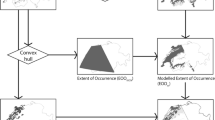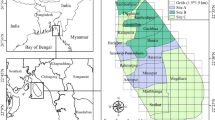Abstract
The first step towards the preservation of endangered species is to establish an appropriate ranking system, which assigns different nature conservation priority scores to different taxa. The system developed by Millsap et al. (Wildlife Monograph 1990, 111: 1–57) has been modified and applied to the mammal, bird, reptile, and amphibian species of Hungary. Three variable groups have been compiled, including eight (measuring biological characteristics), three (features of the Hungarian population) and five (evaluation of research and conservation actions) variables, respectively. In cooperation with several experts, we gave scores to all 379 taxa considered. The most endangered taxon proved to be the Hungarian Meadow Viper (Vipera ursinii rakosiensis), which occurs only in Hungary with just a few hundred individuals. The species rank depends on the availability and quality of data, so it is urgent to devote more effort to survey and monitoring projects. We present a possible application of the species list, where the taxa are grouped according to their legal status in Hungary (strictly protected, protected, partly protected and not protected), and the validity of this categorisation was tested by applying multivariate discriminant analysis. Only 58.36% of the species were correctly classified. The reasons for stronger than expected protection include popularity, attractiveness, and local rarity, while reasons for lower protection include preference for hunting and control of predators and pests.
Similar content being viewed by others
References
Anon. (1993) 12/1993 Departmental Order of the Minister of Environmental Conservation and Regional Policy. Magyar Közlöng 36: 2002-2044 [in Hungarian]
Anon. (1996) 15/1996 Departmental Order of the Minister of Environmental Conservation and Regional Policy. Magyar Közlöng 64: 4073-4075 [in Hungarian]
Báldi A andCsorba G (1997) Ecological validation to the legal status of terrestrial vertebrates in Hungary. Természetvédelmi Közlemények 5-6: 79-86 [in Hungarian with English summary]
Báldi A,Csorba G andKorsós Z (1994) Setting priorities for the conservation of wildlife species in Hungary, a preliminary report. In: Bissonette JA andKrausman PR (eds) Integrating People and Wildlife for a Sustainable Future. Proceedings of the First International Wildlife Management Congress, pp 633-636. The Wildlife Society, Bethesda, Maryland
Báldi A,Csorba G,Korsós Z andWaliczky Z (1992) Setting priorities for the conservation of terrestrial vertebrates in Hungary. 20th Congress of the Hungarian Biological Society, p 17 [in Hungarian]
Báldi A,Csorba G andKorsós Z (1995) Setting Priorities for the Conservation of Terrestrial Vertebrates in Hungary. Hungarian Natural History Museum, Budapest, Hungary [in Hungarian with English summary]
Cogger HG, et al. (1993) Action Plan for Australian Reptiles. Australian Nature Protection Agency, ESP Project No. 124
Fekete G, et al. (1994) Foundations for developing a national strategy of biodiversity conservation. Acta Zoologica Hungarica 40: 289-327
Given DR andNorton DA (1993) A multivariate approach to assessing threat and for priority setting in threatened species conservation. Biological Conservation 64: 57-66
Groombridge B (ed) (1993) 1994 IUCN Red List of Threatened Animals. IUCN, Gland, Switzerland/Cambridge, UK
Horváth F,Korsós Z,Kovácsné-Láng E andMatskási I (eds) (1997) Hungarian National Biodiversity Monitoring System. I-X. Hungarian Natural History Museum, Budapest, Hungary
IUCN (1990) 1990 IUCN Red List of Threatened Animals. IUCN, Gland, Switzerland/Cambridge, UK
IUCN Species Survival Commission (1994) IUCN Red List Categories. IUCN, Gland, Switzerland
Kelemen J (1997) Guidelines for the Nature Conservation Management of Grasslands. Természetbuvár Alapítvány, Budapest, Hungary [in Hungarian]
Korsós Z (1991) The most threatened venomous snake of Europe, the Vipera ursinii rakosiensis. Természetvédelmi Közlemények 1: 83-88
Kovács M andKiss I (1995) Nature and Land Conservation. Gödöll?o University of Agricultural Sciences, Gödöll?o, Hungary [in Hungarian]
Mace GM (1995) Classification of threatened species and its role in conservation planning. In: Lawton JH andMay RM (eds) Extinction Rates, pp 198-213. Oxford University Press, Oxford
Magyar G,Hadarics T,Waliczky Z,Schmidt A,Nagy T andBankovics A (1998) Nomenclator Avium Hungariae. An Annotated List of the Birds of Hungary. Madártani Intézet, MME,Winter Fair, Budapest, Szeged, Hungary
Margóczi K (1998) Conservation Biology. JATE Press, Szeged, Hungary [in Hungarian]
Margóczi K,Báldi A,Dévai Gy andHorváth F (1997) Ecological research priorities for nature conservation. Természetvédelmi Közlemények 5-6: 5-16 [in Hungarian with English summary]
Millsap BA,Gore JA,Runde DE andCerulean SI (1990) Setting priorities for the conservation of fish and wildlife species in Florida. Wildlife Monograph 111: 1-57
Moskát C,Báldi A andMahunka S (1993) Conservation of biodiversity in Hungary: history, strategy and examples. Manuscript Collection of International Symposium on Biodiversity and Conservation, pp 36-92. Korean Entomological Institute, Seoul
Pinchera F,Boitani L andCorsi F (1997) Application to the terrestrial vertebrates of Italy of a system proposed by IUCN for a new classification of national Red List categories. Biodiversity Conservation 6: 959-978
Rakonczay Z (ed) (1990) Red Data Book. Extinct and Threatened Plant and Animal Species of Hungary. Akadémiai Kiadó, Budapest [in Hungarian with English summary]
Tucker GM andHeath MF (1994) Birds in Europe. Their Conservation Status. BirdLife International, Cambridge, UK
Újvári B,Korsós Z andPéchy T (2000) Life history, population characteristics and conservation of the Hungarian meadow viper (Vipera ursinii rakosiensis). Amphibia-Reptilia 21: 267-278
Won P-O (1991) Setting priorities for the conservation of avian species in Korea. Nature Conservation 74: 35-48 [ in Korean with English summary]
Author information
Authors and Affiliations
Rights and permissions
About this article
Cite this article
Báldi, A., Csorba, G. & Korsós, Z. Setting priorities for the conservation of terrestrial vertebrates in Hungary. Biodiversity and Conservation 10, 1283–1296 (2001). https://doi.org/10.1023/A:1016682227007
Issue Date:
DOI: https://doi.org/10.1023/A:1016682227007




